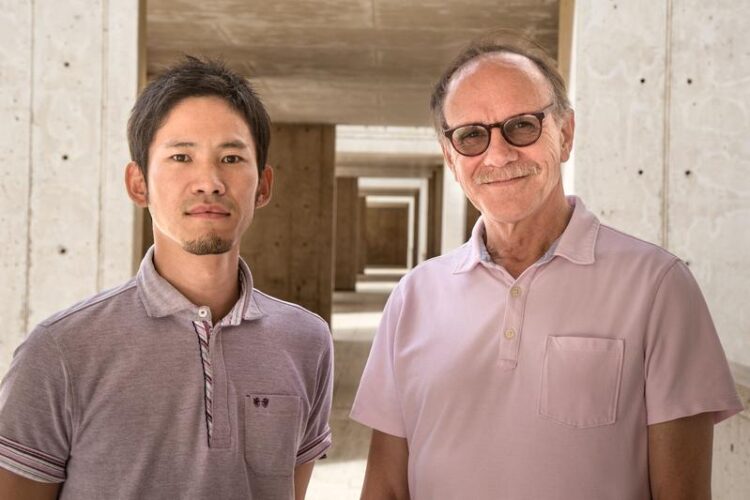Previously ignored DNA sequence

Professor Tomohisa Toda, Erlangen (left), and Professor Rusty Gage, La Jolla (right)
© Salk Institute
… plays important role in brain development.
An international research team has uncovered that a previously overlooked repetitive DNA element known as Long Interspersed Nuclear Element (L1) helps maintain neural progenitor cells, and thus plays an important role in mammalian brain development. The study, published recently in the journal Cell Reports, was led by Tomohisa Toda, Professor of Neural Epigenomics at the Friedrich-Alexander-Universität Erlangen-Nürnberg (FAU), associated with the Max-Planck-Zentrum für Physik und Medizin, Erlangen, together with Professor Rusty Gage, PhD, at the Salk Institute, La Jolla, CA USA.
The human genome provides the basic blueprint and circuit diagram to guide complex brain development. Depending on which genes are turned “on” or “off,” cells proliferate and mature specifically into neurons or other brain cells. A complex interplay of genetic and molecular factors, which is still not completely understood, ensures that cells are generated, migrate, and mature at the correct times and locations.
Repetitive elements, sequences of DNA consisting of repeating segments, compose more than half of the human genome. One of the most abundant of these elements is L1, which accounts for almost 20% of human and mouse genomes. L1s are retrotransposons, meaning they can copy and paste themselves to other positions within chromosomes, thus contributing to the evolution of mammalian genomes. Repetitive elements such as L1 were previously considered to be genomic junk. Cells typically suppress L1 as uncontrolled expression can lead to genomic instability and negatively affect the expression of neighboring genes, eventually contributing to cancer or age-related neurodegenerative diseases.
In contrast to the previous understanding, Toda, and Gage, and team have now demonstrated that the expression of this repetitive element is crucial for brain development. Using sophisticated genetic experiments that combined animal and human stem cell models, the scientists showed that silencing L1 triggered early neuronal differentiation. In contrast, enhancing L1 expression prevented early differentiation into neural progenitor cells. The findings also indicated that L1 may work as an epigenetic factor to regulate neural progenitor cells.
“Actively transcribing L1 mobile elements have long been considered dangerous and or damaging to the cells that express them,” Gage said. “Our study reveals that these evolutionarily ancient genetic elements have been exapted to play a positive role in neural development.” Toda adds ”In the future, understanding how L1 regulates NPCs may uncover how human brain has evolved, and how L1 contributes to pathophysiological development in brain diseases”.
Wissenschaftliche Ansprechpartner:
Prof Dr Tomohisa Toda
Laboratory of Neural Epigenomics
Institute of Medical Physics and Micro-tissue Engineering
Friedrich-Alexander-Universität Erlangen-Nürnberg
www.fau.de / tomohisa.toda@fau.de
Prof. Rusty Gage, PhD
Laboratory of Genetics
Salk Institute for Biological Studies
www.salk.edu / gage@salk.edu
Originalpublikation:
Original publication in Cell Reports
Toda et al., Long interspersed nuclear elements safeguard neural progenitors from precocious differentiation, Cell Reports (2024).
Media Contact
All latest news from the category: Life Sciences and Chemistry
Articles and reports from the Life Sciences and chemistry area deal with applied and basic research into modern biology, chemistry and human medicine.
Valuable information can be found on a range of life sciences fields including bacteriology, biochemistry, bionics, bioinformatics, biophysics, biotechnology, genetics, geobotany, human biology, marine biology, microbiology, molecular biology, cellular biology, zoology, bioinorganic chemistry, microchemistry and environmental chemistry.
Newest articles

Combatting disruptive ‘noise’ in quantum communication
In a significant milestone for quantum communication technology, an experiment has demonstrated how networks can be leveraged to combat disruptive ‘noise’ in quantum communications. The international effort led by researchers…

Stretchable quantum dot display
Intrinsically stretchable quantum dot-based light-emitting diodes achieved record-breaking performance. A team of South Korean scientists led by Professor KIM Dae-Hyeong of the Center for Nanoparticle Research within the Institute for…

Internet can achieve quantum speed with light saved as sound
Researchers at the University of Copenhagen’s Niels Bohr Institute have developed a new way to create quantum memory: A small drum can store data sent with light in its sonic…





















